Page 25 of 587
INTERIOR
Interior Features
1 — Power Window Switches
2 — Headlight Switch
3 — Instrument Cluster
4 — Audio System
5 — Glove Compartment6 — Seats
7 — Switch Panel
8 — Transmission Shift Lever (Automatic/Manual Options)
9 — Electronic Speed Controls
10 — EVIC Controls
3
GRAPHICAL TABLE OF CONTENTS 23
Page 29 of 587

�BLIND SPOT MONITORING (BSM) — IF
EQUIPPED ............................82
▫ Rear Cross Path (RCP) ..................88
▫ Mode Of Operation .....................90
▫ Blind Spot Monitoring Fault Warnings .......91
▫ General Information ....................92
� EXTERIOR LIGHTS ......................92
▫ Headlights ...........................92
▫ Automatic Lighting — If Equipped .........93
▫
Daytime Running Lights (DRL) — If Equipped . .94
▫ Front Fog Lights — If Equipped ...........94
▫ Parking Lights ........................95
▫ Headlight Delay .......................95 ▫
High Beams ..........................95
▫ Turn Signals .........................96
� INTERIOR LIGHTS ......................96
▫ Front Courtesy Light ....................96
▫ Rear Dome Light — If Equipped ...........100
▫ Cargo Area Lights .....................101
▫ Instrument Panel Dimmer And Ambient Light
Control ........................... .101
� WIPERS AND WASHERS .................102
▫ Front Wiper Operation .................102
▫ Rain Sensor — If Equipped ..............104
▫ Rear Window Wiper/Washer .............106
▫ Windshield Wiper De-Icer — If Equipped . . . .107
4
GETTING TO KNOW YOUR VEHICLE 27
Page 30 of 587
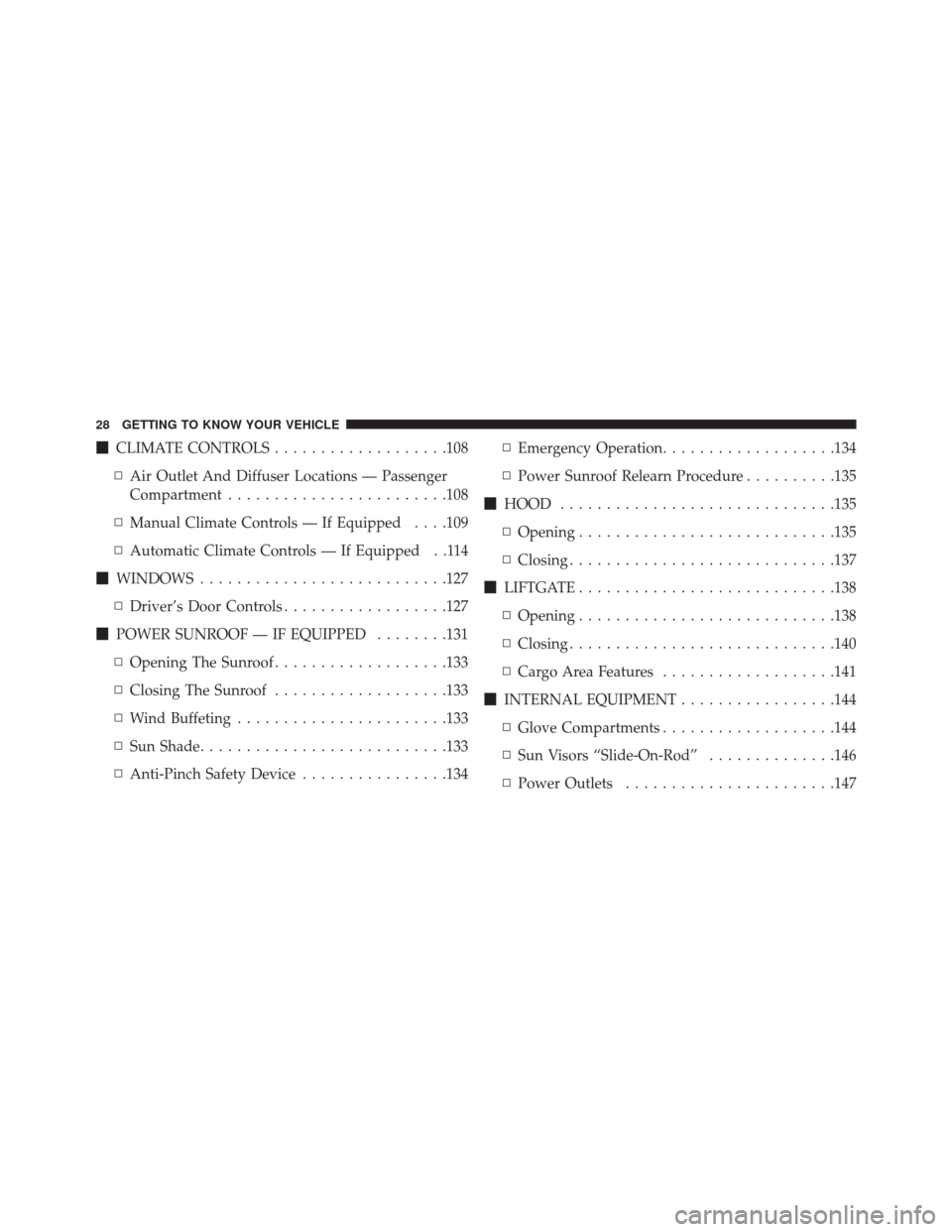
�CLIMATE CONTROLS ...................108
▫ Air Outlet And Diffuser Locations — Passenger
Compartment ....................... .108
▫ Manual Climate Controls — If Equipped . . . .109
▫ Automatic Climate Controls — If Equipped . .114
� WINDOWS .......................... .127
▫ Driver’s Door Controls ..................127
� POWER SUNROOF — IF EQUIPPED ........131
▫ Opening The Sunroof ...................133
▫ Closing The Sunroof ...................133
▫ Wind Buffeting ...................... .133
▫ Sun Shade .......................... .133
▫ Anti-Pinch Safety Device ................134 ▫
Emergency Operation ...................134
▫ Power Sunroof Relearn Procedure ..........135
� HOOD ............................. .135
▫ Opening ........................... .135
▫ Closing ............................ .137
� LIFTGATE ........................... .138
▫ Opening ........................... .138
▫ Closing ............................ .140
▫ Cargo Area Features ...................141
� INTERNAL EQUIPMENT .................144
▫ Glove Compartments ...................144
▫ Sun Visors “Slide-On-Rod” ..............146
▫ Power Outlets ...................... .147
28 GETTING TO KNOW YOUR VEHICLE
Page 43 of 587
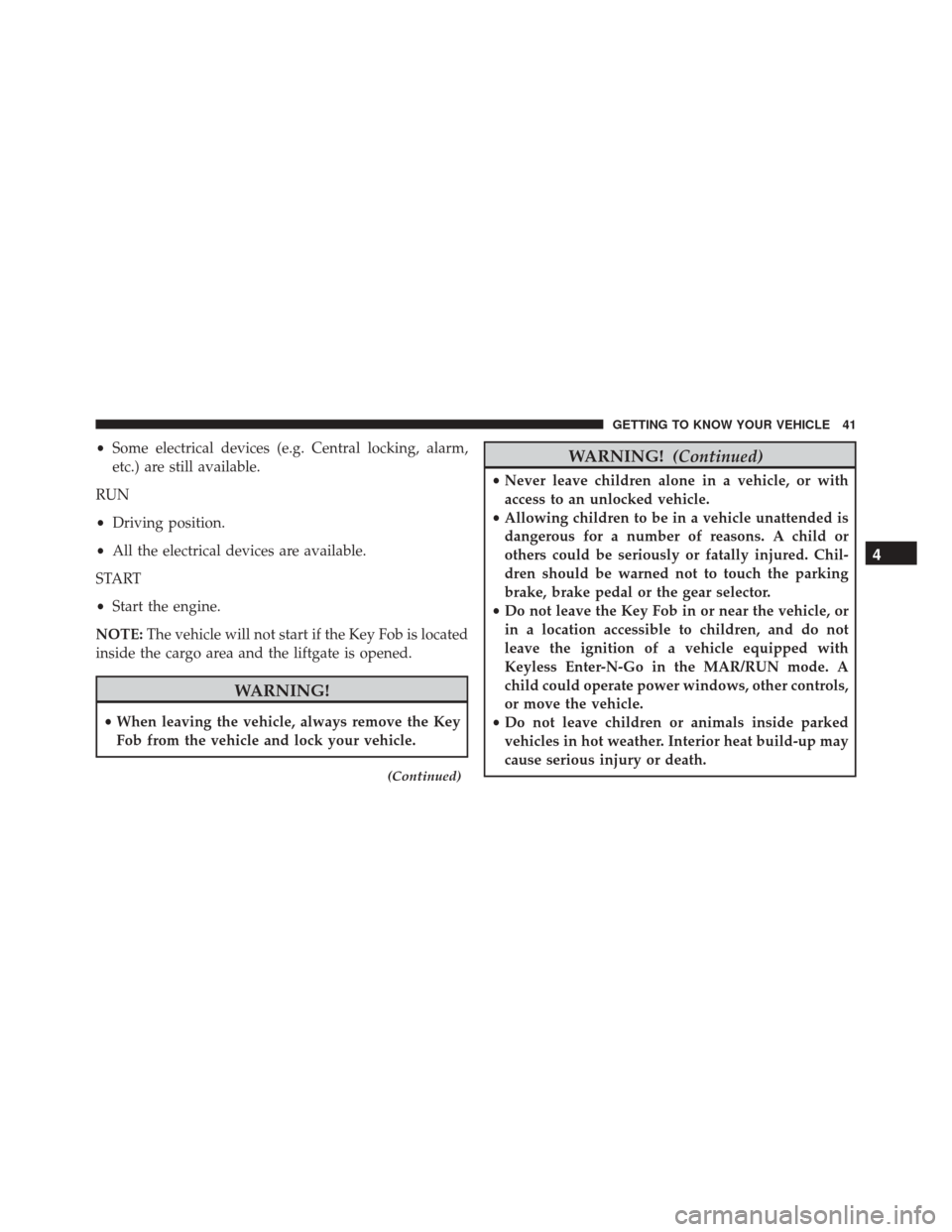
•Some electrical devices (e.g. Central locking, alarm,
etc.) are still available.
RUN
• Driving position.
• All the electrical devices are available.
START
• Start the engine.
NOTE: The vehicle will not start if the Key Fob is located
inside the cargo area and the liftgate is opened.
WARNING!
• When leaving the vehicle, always remove the Key
Fob from the vehicle and lock your vehicle.
(Continued)
WARNING! (Continued)
•Never leave children alone in a vehicle, or with
access to an unlocked vehicle.
• Allowing children to be in a vehicle unattended is
dangerous for a number of reasons. A child or
others could be seriously or fatally injured. Chil-
dren should be warned not to touch the parking
brake, brake pedal or the gear selector.
• Do not leave the Key Fob in or near the vehicle, or
in a location accessible to children, and do not
leave the ignition of a vehicle equipped with
Keyless Enter-N-Go in the MAR/RUN mode. A
child could operate power windows, other controls,
or move the vehicle.
• Do not leave children or animals inside parked
vehicles in hot weather. Interior heat build-up may
cause serious injury or death.
4
GETTING TO KNOW YOUR VEHICLE 41
Page 47 of 587
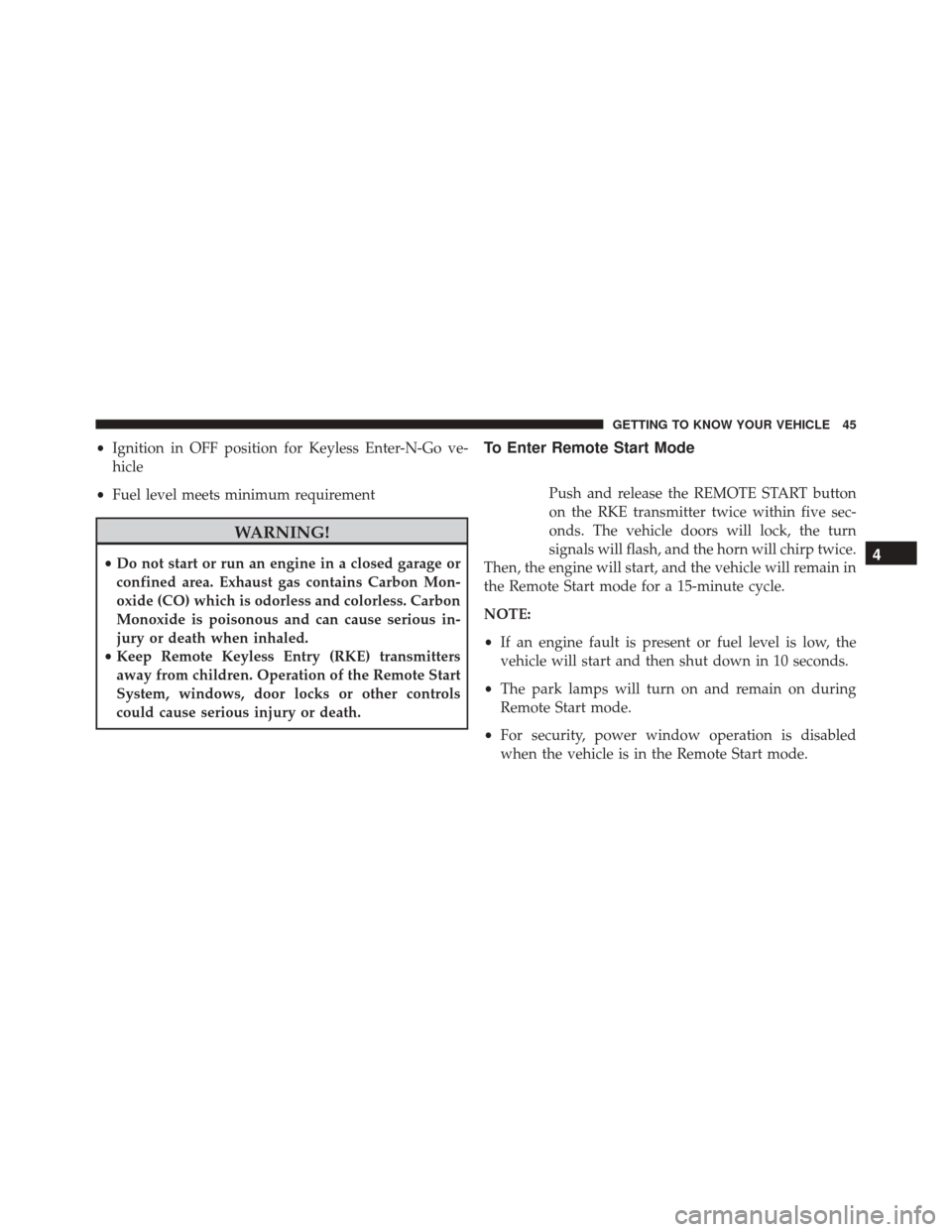
•Ignition in OFF position for Keyless Enter-N-Go ve-
hicle
• Fuel level meets minimum requirement
WARNING!
•Do not start or run an engine in a closed garage or
confined area. Exhaust gas contains Carbon Mon-
oxide (CO) which is odorless and colorless. Carbon
Monoxide is poisonous and can cause serious in-
jury or death when inhaled.
• Keep Remote Keyless Entry (RKE) transmitters
away from children. Operation of the Remote Start
System, windows, door locks or other controls
could cause serious injury or death.
To Enter Remote Start Mode
Push and release the REMOTE START button
on the RKE transmitter twice within five sec-
onds. The vehicle doors will lock, the turn
signals will flash, and the horn will chirp twice.
Then, the engine will start, and the vehicle will remain in
the Remote Start mode for a 15-minute cycle.
NOTE:
• If an engine fault is present or fuel level is low, the
vehicle will start and then shut down in 10 seconds.
• The park lamps will turn on and remain on during
Remote Start mode.
• For security, power window operation is disabled
when the vehicle is in the Remote Start mode.
4
GETTING TO KNOW YOUR VEHICLE 45
Page 55 of 587
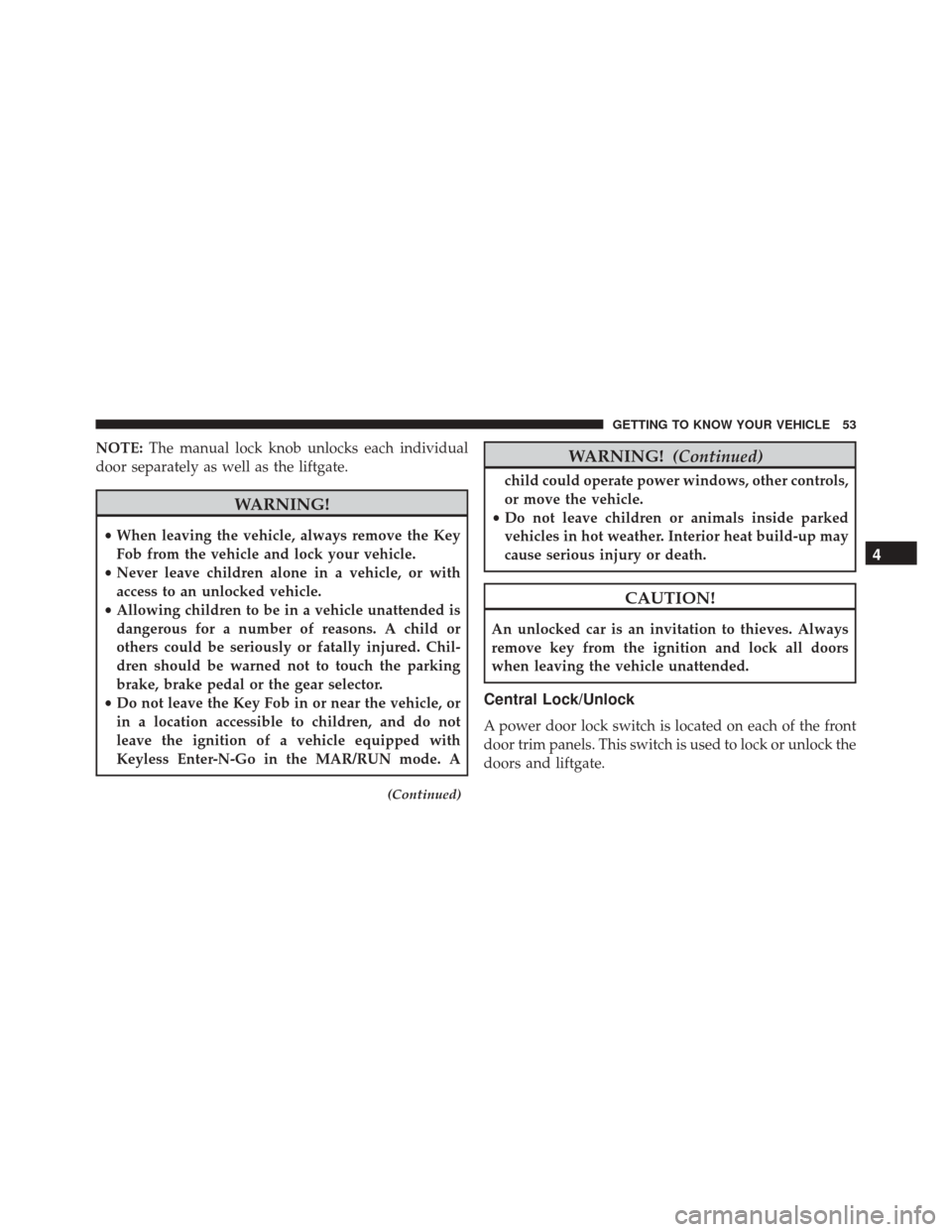
NOTE:The manual lock knob unlocks each individual
door separately as well as the liftgate.
WARNING!
• When leaving the vehicle, always remove the Key
Fob from the vehicle and lock your vehicle.
• Never leave children alone in a vehicle, or with
access to an unlocked vehicle.
• Allowing children to be in a vehicle unattended is
dangerous for a number of reasons. A child or
others could be seriously or fatally injured. Chil-
dren should be warned not to touch the parking
brake, brake pedal or the gear selector.
• Do not leave the Key Fob in or near the vehicle, or
in a location accessible to children, and do not
leave the ignition of a vehicle equipped with
Keyless Enter-N-Go in the MAR/RUN mode. A
(Continued)
WARNING! (Continued)
child could operate power windows, other controls,
or move the vehicle.
• Do not leave children or animals inside parked
vehicles in hot weather. Interior heat build-up may
cause serious injury or death.
CAUTION!
An unlocked car is an invitation to thieves. Always
remove key from the ignition and lock all doors
when leaving the vehicle unattended.
Central Lock/Unlock
A power door lock switch is located on each of the front
door trim panels. This switch is used to lock or unlock the
doors and liftgate.
4
GETTING TO KNOW YOUR VEHICLE 53
Page 62 of 587
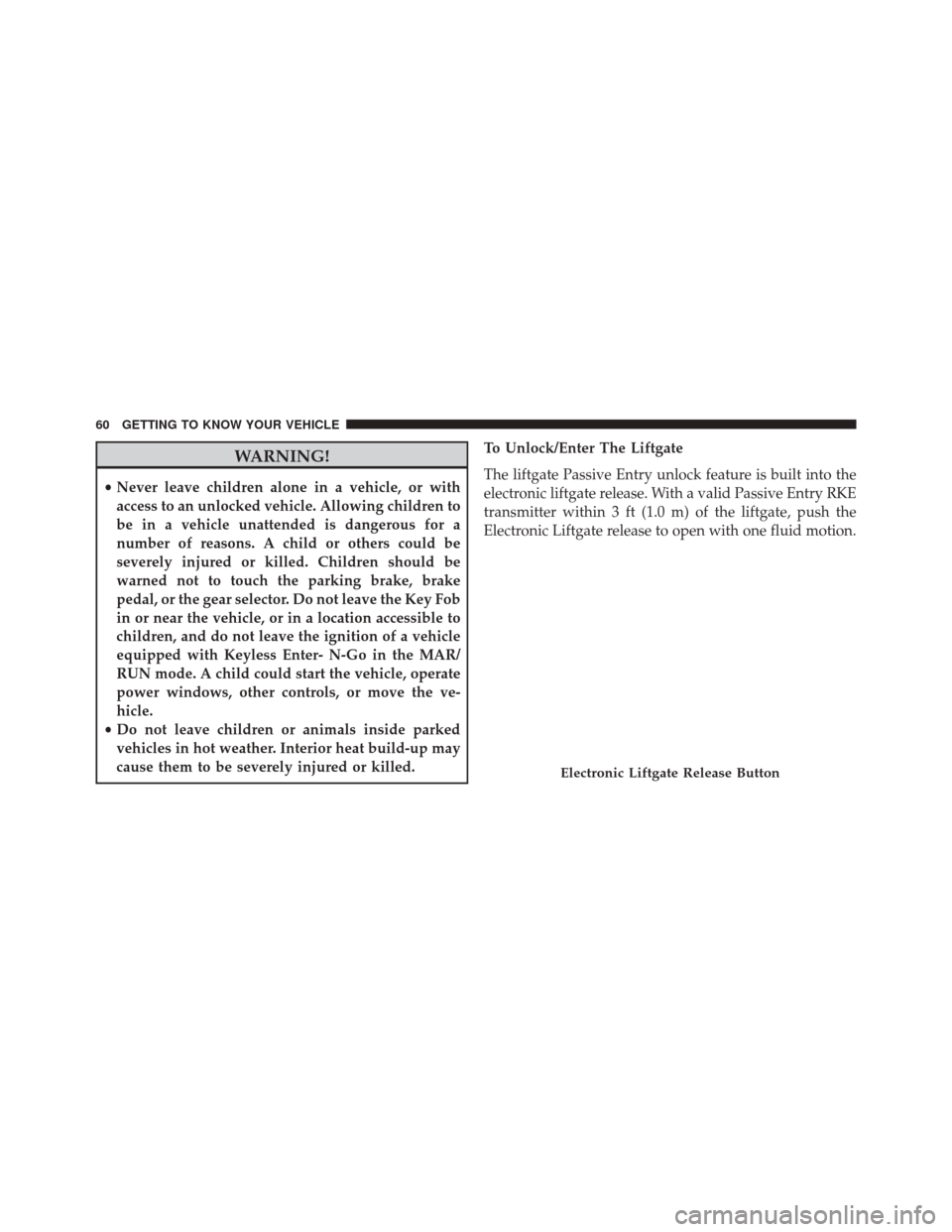
WARNING!
•Never leave children alone in a vehicle, or with
access to an unlocked vehicle. Allowing children to
be in a vehicle unattended is dangerous for a
number of reasons. A child or others could be
severely injured or killed. Children should be
warned not to touch the parking brake, brake
pedal, or the gear selector. Do not leave the Key Fob
in or near the vehicle, or in a location accessible to
children, and do not leave the ignition of a vehicle
equipped with Keyless Enter- N-Go in the MAR/
RUN mode. A child could start the vehicle, operate
power windows, other controls, or move the ve-
hicle.
• Do not leave children or animals inside parked
vehicles in hot weather. Interior heat build-up may
cause them to be severely injured or killed. To Unlock/Enter The Liftgate
The liftgate Passive Entry unlock feature is built into the
electronic liftgate release. With a valid Passive Entry RKE
transmitter within 3 ft (1.0 m) of the liftgate, push the
Electronic Liftgate release to open with one fluid motion.
Electronic Liftgate Release Button
60 GETTING TO KNOW YOUR VEHICLE
Page 65 of 587
NOTE:
•When the child lock system is engaged, the door can
only be opened by using the outside door handle even
though the inside door lock is in the unlocked position.
• After disengaging the Child-Protection Door Lock
system, always test the door from the inside to make
certain it is in the desired position.
• After engaging the Child-Protection Door Lock sys-
tem, always test the door from the inside to make
certain it is in the desired position.
• For emergency exit with the system engaged, rotate
the lock button to the unlocked position, roll down the
window, and open the door with the outside door
handle.WARNING!
Avoid trapping anyone in a vehicle in a collision.
Remember that the rear doors can only be opened
from the outside when the Child-Protection locks are
engaged.
SEATS
Seats are a part of the Occupant Restraint System of the
vehicle.
4
GETTING TO KNOW YOUR VEHICLE 63